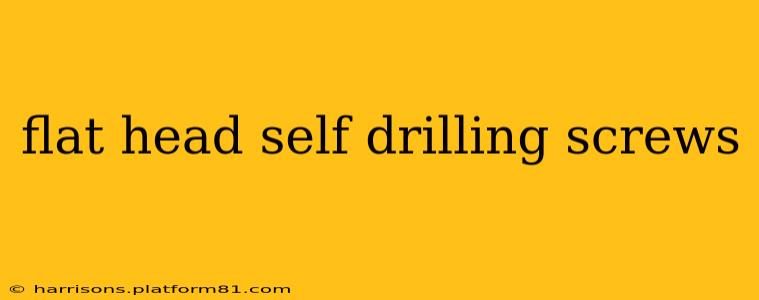Flat head self-drilling screws are a versatile and efficient fastening solution used across numerous industries. Their unique design allows them to drill a pilot hole and drive themselves into various materials, eliminating the need for pre-drilling in many applications. This guide will delve into the specifics of these screws, exploring their benefits, applications, and considerations for choosing the right ones for your project.
What are Flat Head Self Drilling Screws?
Flat head self-drilling screws, also known as self-tapping screws with a flat head, combine the functions of a drill bit and a screw. The screw's point is designed to penetrate materials, while the threads create a secure hold. The flat head profile sits flush against the surface, providing a clean, aesthetically pleasing finish. Unlike pan head or oval head self-drilling screws, the flat head offers a lower profile. This makes them ideal where a low-profile fastening is required.
What are the Benefits of Using Flat Head Self Drilling Screws?
The primary advantage of flat head self-drilling screws is their speed and efficiency. Eliminating the need for pre-drilling significantly reduces installation time and labor costs, particularly in large-scale projects. Other key benefits include:
- Ease of Use: They are simple to install, requiring only a screwdriver or drill.
- Strong Hold: Their threads create a secure and durable connection.
- Versatile Applications: Suitable for a wide range of materials.
- Clean Finish: The flat head provides a smooth, flush surface.
- Cost-Effective: Reduces labor costs associated with pre-drilling.
What Materials are Flat Head Self Drilling Screws Used With?
These versatile screws are used with a variety of materials, including:
- Sheet Metal: A common application due to their ability to penetrate thin metal without splitting or damaging it.
- Wood: Can be used for wood applications, though pre-drilling might be needed for harder woods to prevent splitting.
- Plastic: Suitable for many plastics, depending on the screw's material and the plastic's hardness.
- Aluminum: Often used for fastening aluminum components.
What Sizes and Types of Flat Head Self Drilling Screws are Available?
Flat head self-drilling screws come in various sizes and materials to suit different applications. Size is typically specified by length and gauge (diameter). Common materials include:
- Steel: Offers high strength and durability.
- Stainless Steel: Provides superior corrosion resistance.
- Zinc-Plated Steel: Offers corrosion protection.
How Do I Choose the Right Flat Head Self Drilling Screw for My Project?
Selecting the appropriate screw depends on several factors:
- Material being fastened: The screw's material and point design must be compatible with the material being fastened.
- Thickness of material: Choose a screw length that's appropriate for the material thickness, ensuring sufficient engagement.
- Desired strength: Select a screw material and diameter that will provide the necessary holding power.
- Aesthetic considerations: While the flat head offers a low profile, ensure it's appropriate for the overall design.
What are Some Common Applications of Flat Head Self Drilling Screws?
Flat head self-drilling screws find applications in diverse industries:
- Automotive: Used in body panels, chassis components, and other automotive applications.
- Construction: Used for fastening metal sheeting, roofing, and other construction materials.
- Manufacturing: Used in various manufacturing processes for assembling metal components.
- HVAC: Used in assembling HVAC systems and components.
Are there any disadvantages to using flat head self drilling screws?
While offering many advantages, it's important to consider some potential drawbacks:
- Potential for damage: Incorrectly using self-drilling screws can damage the material being fastened, especially if pre-drilling isn't done for harder materials.
- Limited material compatibility: They might not be suitable for all materials. For some harder plastics or denser woods, pre-drilling is often necessary.
- Cam-out: The screw head might slip off the screwdriver bit, particularly when working on uneven surfaces.
What is the difference between self-drilling and self-tapping screws?
While the terms are often used interchangeably, there's a subtle difference. Self-drilling screws create their own pilot hole, while self-tapping screws typically require a pre-drilled hole, though the hole size is usually smaller than with conventional screws. Flat head self-drilling screws create their own hole entirely.
How do I install flat head self-drilling screws correctly?
Proper installation involves ensuring the material is securely clamped, applying even pressure, and using the correct screwdriver or drill bit. Avoid excessive force to prevent damaging the material or stripping the screw head.
This comprehensive guide provides a thorough understanding of flat head self-drilling screws. Remember to always choose the right screw for your specific project and follow appropriate safety precautions.
